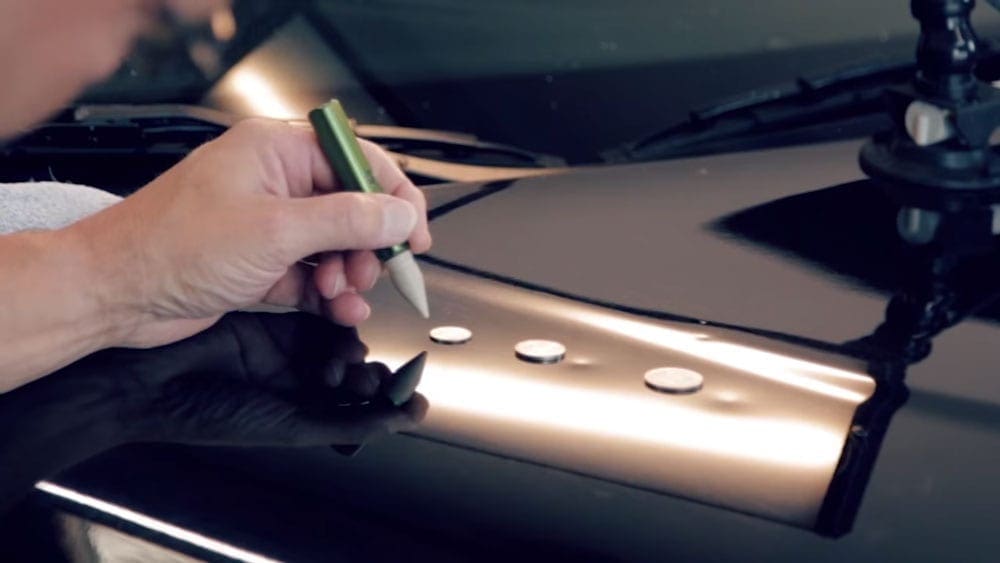Understanding the Difference Between Door Dings, Creases, and Hail Dents in PDR
At Dent Repair School, one of the most valuable skills students learn is the ability to identify the type of dent they are repairing and to choose the correct repair strategy accordingly. While all dents may appear similar at first glance, door dings, creases, and hail dents each have unique shapes, tension patterns, metal memory characteristics, and reflection behavior. The technician must know not only how to move metal, but how to recognize what kind of metal movement is required. Accurate dent identification leads to correct tool choice, correct pressure direction, and a clean final finish.
In Paintless Dent Repair, the metal tells the story. Each type of dent forms differently and therefore must be repaired differently. Door dings are localized and compact, creases are directional and elongated, and hail dents are numerous and shallow. The skill is not simply pushing dents out; it is understanding how the metal was displaced in the first place, and how to return it to its original shape without damaging clear coat or altering surface reflection. Dent Repair School trains students to read these characteristics in real time so repairs become controlled rather than experimental.
“The dent will always tell you what it needs — if you learn how to see it.”
Door Dings
Door dings are typically caused by direct, isolated impact. They tend to have a central low with an evenly distributed pressure ring. Because the impact is compact, metal movement is mostly vertical, and the repair approach focuses on lifting the center gradually while maintaining control of the surrounding crown. Students learn to use precise tool tip control to raise the metal evenly, ensuring the reflection becomes smooth and uninterrupted. Door dings are often a student’s first step in developing accuracy and pressure sensitivity.
Creases
Creases require a different approach. A crease is not a single low point; it is a line of displaced metal. The metal along the length of the crease has been stretched and redirected. Instead of a central push, the technician must rebuild shape along the entire length gradually. Reflection reading becomes essential here, because every section of the crease must align for the final finish to look flawless. Creases teach technicians patience, controlled movement, and the importance of restoring panel geometry rather than only lifting lows.
Hail Dents
Hail dents appear in clusters and vary in size depending on storm intensity. Because hail strikes the panel at high velocity, the metal may have both a low point and a micro-high surrounding edge. The technician must identify depth, count patterns, and work panel sections methodically to avoid over-correcting or leaving texture inconsistencies. Hail teaches the student focus, endurance, and the importance of rhythm in repair work. Hail repair also reinforces the necessity of establishing a repeatable workflow.
Side-by-Side Repair Strategy Comparison
| Dent Type | Shape Characteristics | Primary Repair Focus | Key Skill Required | Typical Tool Approach |
|---|---|---|---|---|
| Door Ding | Compact central low | Lift and balance center | Tip accuracy | Internal rod access or controlled surface pulling |
| Crease Dent | Elongated channel-shaped distortion | Rebuild along the length | Reflection alignment | Slow, progressive movement along crease |
| Hail Dent | Numerous, shallow distributed lows | Even panel correction | Consistency and rhythm | Tool access with finishing knockdowns |
The more clearly a technician identifies the dent type, the more efficiently and cleanly the repair is completed.
How Reflection Reveals Differences
Reflection lines behave differently depending on the dent type. Door dings compress the reflection in one tight point. Creases distort reflection across a line, showing directional flow. Hail dents show subtle shadow pools across the panel. Learning to read reflection allows the technician to make informed decisions rather than assumptions. This is why Dent Repair School emphasizes lighting and visual training from the very beginning. The mastery of PDR is the mastery of reflection.
Metal Memory and Surface Tension
Metal wants to return to its original shape — but only when guided correctly. Door dings cooperate quickly when pressure is precise. Creases resist because the displacement is distributed. Hail dents respond best to consistent and measured correction across the entire panel. Students practice learning where the metal is willing to move and where it must be persuaded gradually. Mastery of PDR is as much about feel as it is about technique.
Key Takeaways
Different dent types require different repair strategies, even when the damage seems similar.
Door dings, creases, and hail dents each have unique reflection patterns that guide the repair process.
Understanding metal movement is essential to producing clean, invisible repairs.
Learning to read reflection is the foundation of all advanced PDR skill.
FAQs
Q: Are creases harder to repair than door dings?
Yes. Creases require restoring shape along their entire length, which demands higher control and reflection awareness.
Q: Why are hail dents repaired in patterns rather than individually?
Repairing systematically ensures uniform reflection and prevents uneven surface texture.
Q: Can all small dents be repaired using the same tools?
Tools must be selected based on access, shape, and metal tension. One tool does not fit all repairs.
Conclusion
Every dent is a lesson in how metal moves, reflects, and returns to form. By learning to recognize the difference between door dings, creases, and hail dents, the technician gains the ability to choose the correct strategy before the first push is ever made. Dent Repair School teaches students to see dents not as flaws to remove, but as shapes to restore. With this understanding, repairs become precise, consistent, and professional — the true mark of a skilled PDR technician.



